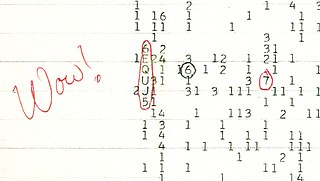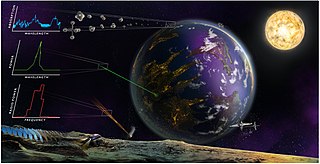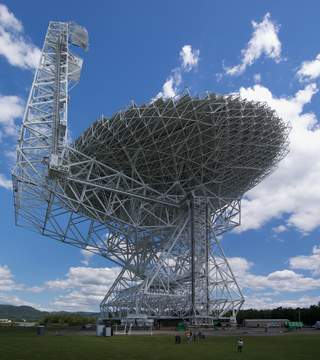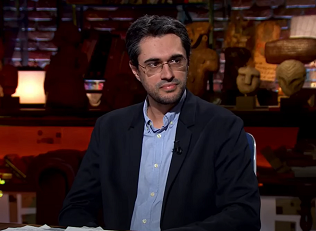
Alpha Centauri is a triple star system in the southern constellation of Centaurus. It consists of three stars: Rigil Kentaurus, Toliman, and Proxima Centauri. Proxima Centauri is the closest star to the Sun at 4.2465 light-years (1.3020 pc).
Extraterrestrial life, or alien life, is life which does not originate from Earth. No extraterrestrial life has yet been scientifically conclusively detected. Such life might range from simple forms such as prokaryotes to intelligent beings, possibly bringing forth civilizations that might be far more advanced than humans. The Drake equation speculates about the existence of sapient life elsewhere in the universe. The science of extraterrestrial life is known as astrobiology.
The search for extraterrestrial intelligence (SETI) is a collective term for scientific searches for intelligent extraterrestrial life, for example, monitoring electromagnetic radiation for signs of transmissions from civilizations on other planets.

Proxima Centauri is the nearest star to Earth after the Sun, located 4.25 light-years away in the southern constellation of Centaurus. This object was discovered in 1915 by Robert Innes. It is a small, low-mass star, too faint to be seen with the naked eye, with an apparent magnitude of 11.13. Its Latin name means the 'nearest [star] of Centaurus'. Proxima Centauri is a member of the Alpha Centauri star system, being identified as component Alpha Centauri C, and is 2.18° to the southwest of the Alpha Centauri AB pair. It is currently 12,950 AU (0.2 ly) from AB, which it orbits with a period of about 550,000 years.
Stellar radio sources, radio source stars or radio stars are stellar objects that produce copious emissions of various radio frequencies, whether constant or pulsed. Radio emissions from stars can be produced in many varied ways.
SHGb02+14a is an astronomical radio source and a candidate in the Search for Extra-Terrestrial Intelligence (SETI), discovered in March 2003 by SETI@home and announced in New Scientist on September 1, 2004.

The Wow! signal was a strong narrowband radio signal detected on August 15, 1977, by Ohio State University's Big Ear radio telescope in the United States, then used to support the search for extraterrestrial intelligence. The signal appeared to come from the direction of the constellation Sagittarius and bore expected hallmarks of extraterrestrial origin.

The Allen Telescope Array (ATA), formerly known as the One Hectare Telescope (1hT), is a radio telescope array dedicated to astronomical observations and a simultaneous search for extraterrestrial intelligence (SETI). The array is situated at the Hat Creek Radio Observatory in Shasta County, 290 miles (470 km) northeast of San Francisco, California.

Abraham "Avi" Loeb is an Israeli-American theoretical physicist who works on astrophysics and cosmology. Loeb is the Frank B. Baird Jr. Professor of Science at Harvard University, where since 2007 he has been Director of the Institute for Theory and Computation at the Center for Astrophysics. He chaired the Department of Astronomy from 2011 to 2020, and founded the Black Hole Initiative in 2016.
SERENDIP is a Search for Extra-Terrestrial Intelligence (SETI) program originated by the Berkeley SETI Research Center at the University of California, Berkeley.

Technosignature or technomarker is any measurable property or effect that provides scientific evidence of past or present technology. Technosignatures are analogous to biosignatures, which signal the presence of life, whether intelligent or not. Some authors prefer to exclude radio transmissions from the definition, but such restrictive usage is not widespread. Jill Tarter has proposed that the search for extraterrestrial intelligence (SETI) be renamed "the search for technosignatures". Various types of technosignatures, such as radiation leakage from megascale astroengineering installations such as Dyson spheres, the light from an extraterrestrial ecumenopolis, or Shkadov thrusters with the power to alter the orbits of stars around the Galactic Center, may be detectable with hypertelescopes. Some examples of technosignatures are described in Paul Davies's 2010 book The Eerie Silence, although the terms "technosignature" and "technomarker" do not appear in the book.

Breakthrough Listen is a project to search for intelligent extraterrestrial communications in the Universe. With $100 million in funding and thousands of hours of dedicated telescope time on state-of-the-art facilities, it is the most comprehensive search for alien communications to date. The project began in January 2016, and is expected to continue for 10 years. It is a component of Yuri Milner's Breakthrough Initiatives program. The science program for Breakthrough Listen is based at Berkeley SETI Research Center, located in the Astronomy Department at the University of California, Berkeley.
Breakthrough Initiatives is a science-based program founded in 2015 and funded by Julia and Yuri Milner, also of Breakthrough Prize, to search for extraterrestrial intelligence over a span of at least 10 years. The program is divided into multiple projects. Breakthrough Listen will comprise an effort to search over 1,000,000 stars for artificial radio or laser signals. A parallel project called Breakthrough Message is an effort to create a message "representative of humanity and planet Earth". The project Breakthrough Starshot, co-founded with Mark Zuckerberg, aims to send a swarm of probes to the nearest star at about 20% the speed of light. The project Breakthrough Watch aims to identify and characterize Earth-sized, rocky planets around Alpha Centauri and other stars within 20 light years of Earth. Breakthrough plans to send a mission to Saturn's moon Enceladus, in search for life in its warm ocean, and in 2018 signed a partnership agreement with NASA for the project.
HD 164595 b is a confirmed exoplanet orbiting around a Sun-like star HD 164595 every 40 days some 94.36 light-years away. It was detected with the radial velocity technique with the SOPHIE echelle spectrograph. The planet has a minimal mass equivalent of 16 Earths.

HD 164595 is a wide binary star system in the northern constellation of Hercules. The primary component of this pair hosts an orbiting exoplanet. The system is located at a distance of 92 light years from the Sun based on parallax measurements, and is drifting further away with a radial velocity of 2.0 km/s. Although it has an absolute magnitude of +4.81, at that distance it is too faint to be viewed with the naked eye, having an apparent visual magnitude of 7.07. The brighter star can be found with binoculars or a small telescope less than a degree to the east-northeast of Xi Herculis. HD 164595 has a relatively large proper motion, traversing the celestial sphere at an angular rate of 0.222″ yr−1.

Proxima Centauri b, also referred to as Alpha Centauri Cb, is an exoplanet orbiting within the habitable zone of the red dwarf star Proxima Centauri, which is the closest star to the Sun and part of the larger triple star system Alpha Centauri. It is about 4.2 light-years from Earth in the constellation Centaurus, making it and Proxima d, along with the currently disputed Proxima c, the closest known exoplanets to the Solar System.

The Berkeley SETI Research Center (BSRC) conducts experiments searching for optical and electromagnetic transmissions from intelligent extraterrestrial civilizations. The center is based at the University of California, Berkeley.

Alberto Caballero is a Spanish astronomer and science communicator. He is known for having identified a Sun-like star in the sky region where the Wow! signal came from as one of the possible sources of the radio signal. Caballero is also known for founding and coordinating the Habitable Exoplanet Hunting Project, an international effort consisting of more than 30 observatories searching for nearby potentially habitable exoplanets. Data is collected 24/7 from specific stars by observatories located both in the Northern and Southern hemispheres, and an initial list of exoplanet candidates was made public in 2020.

The following outline is provided as an overview of and topical guide to extraterrestrial life:

2MASS 19281982-2640123 is a Sun-like star located in the area of Sagittarius constellation where the Wow! Signal is most widely believed to have originated. The star was identified in a 2022 paper as the most similar to the Sun out of the three solar analogs found inside the sky region. The star is 1,800 light years away; this is approximately 132 light years away from Claudio Maccone's estimation of where the closest communicative civilization to Earth is most likely to exist per his calculated solution to the Drake Equation.













